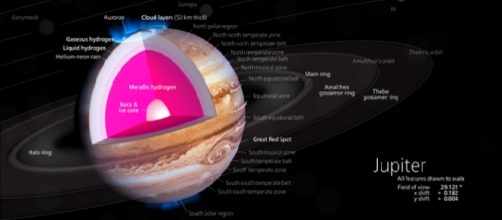Jupiter, as one of the largest bodies orbiting the sun, has had a tremendous influence in the events that occur within. Jupiter is formed of the same light gases, hydrogen and helium, that abound in the sun. it´s believed that Jupiter could have been another star; however, it did not accrued sufficient mass to be a star. It´s thought that the very nature of this planet may provide clues about the origin of the solar system.
Origin of the solar system
It´s believed that approximately 4.5 billion years ago a star exploded in the Milky Way, causing a large cloud of gas and dust to collapse and compress into a rotating disk; eventually, most of the gas and dust accumulated into a compacted core from which the sun was formed.
The remaining fragments formed the planets and other bodies in the solar system; although, it´s not really known how Jupiter formed, as there are some hypothesis about its formation, it´s thought that it may have accrued most of its mass from this cloud of gas and dust in the early formation of the solar system.
Jupiter and the solar system
In addition to the sun, Jupiter exerts an exceptional amount of influence in the solar system. Most orbits of the planets lie closer to Jupiter´s orbital plane than the sun´s equatorial plane, with the exception of Mercury, which lies closer to the sun´s. the shape of the asteroid belt is mostly caused by jupiter and it´s thought that the inner asteroid bombardment of the solar system was mainly triggered by Jupiter.
Most orbits of short-period comets are perturbed during close encounters with jupiter and this planet is bombarded by asteroids hundreds of times more frequently than earth.
Jupiter´s core
Based on most theories, Jupiter possesses a dense core of a combination of elements, above it, a layer of liquid metallic hydrogen and helium and an external layer of molecular hydrogen. During planetary formation, a rocky or icy core is thought to have amassed enough that gravity allowed it to attract its share of hydrogen and helium from the protosolar nebula.
Other theory states that there is no core in the interior of jupiter, instead, Jupiter accrued most of its gas and dust from the nebular cloud and as it cooled and condensed, the light gases grouped together, producing denser distinct regions.
Over time, one of this denser region began to gravitationally attract more light particles together, increasing in size to form the large planet that Jupiter became.
Juno
With the mission in mind to unlock some of the mysteries in jupiter, NASA sent spacecraft Juno to help prove the amount of materials that make up Jupiter. This spacecraft will mapthe magnetic field and gravity to obtain information about the planet´s real core. Juno will also measure the amount of water in Jupiter. It´s believed that the study will provide information about the formation of other similar planets orbiting other stars in the universe.

